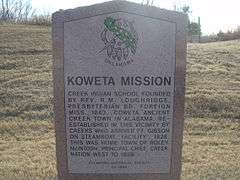Koweta Mission Site
|
Koweta Mission | |
 | |
| Location | Coweta, Oklahoma |
|---|---|
| Built | 1843 |
| Built by | Rev. Robert Loughridge |
| NRHP Reference # | 73001571[1] |
| Added to NRHP | 1973 |
Koweta Mission Site is a site listed on the National Register of Historic Places. In 1843, white missionaries arrived in Coweta to teach the Indian children. Reverend Robert Loughridge and his wife, Olivia, bought an empty cabin for ten dollars and began teaching. He named the mission "Koweta".
History
For a time the Creeks resisted mission work and schools, even outlawing Christianity and preaching. But in 1843, Rev. Robert Loughridge was granted permission to open the Koweta Mission, primarily because Creek leaders recognized a need for education for their children. The Koweta Mission was well received by Creek families who sent their children to study there. Rev. Loughridge wrote in a letter to the white Creek agent, Colonel James Logan, which described the beginning of his work with the Creek people: "Although the old chief at first had a manifested some fears of our religious influence interfering with their old customs, yet he gave us a cordial welcome, and requested me to locate the mission in his town. This I did and called the station Koweta, after the name of his home town. It was situated about 24 miles northwest of Fort Gibson, and one and one-half miles east of the Arkansas River. There was on the place selected a vacant Indian cabin 14x24 feet, with a dirt floor and covered with clapboards. Connected with it was a small unfenced field and a few fruit trees. For the whole premises, I paid the owner ten dollars. As planks could not be hauled a great distance, I had hired some men to split out 'luncheons' and floor the house. In this little cabin we lived happily for more than a year, and in this cabin our first child was born. As by agreement I could only preach at the Mission station. My first object was to build a log house to answer the double purpose of school and church. As soon therefore as it was ready for use, my wife commenced teaching a school of fifteen or twenty children, and the neighbors were invited to attendance at the Mission, while the most of them were devotedly attached to their old customs and superstitions. The outlook was very discouraging." The school operated for about 3 months until sickness and a lack of inadequate accommodations caused the school to be closed temporarily. After a while Rev. Loughridge started to overcome Indian objections and more and more Creeks began to attend his services. Loughridge's wife Olivea gave birth to her second child on September 5, 1845, unfortunately the nearest physician who lived in Fort Gibson was not in the area. Olivia died of puerperal fever on September 17, at the age of twenty-nine. One year later on September 26, 1846 the child died and was buried next to Olivia. Creek officials granted permission for a second school to be built called Tullahassee Mission. It was located 16 miles east of Koweta Mission and 10 miles west of Fort Gibson, it was completed in 1859. The Rev. and Mrs. William Robertson were in charge of this boarding school.[2]
The Koweta Mission was abandoned and then burned during the Civil War. Other schools and churches that had been built were also abandoned among all the tribes. Most of their children had received at least a few years of education. Sadly, the war disrupted the mission work forcing most of the ministers and teachers to leave Indian Territory for the duration of the conflict. Olivia and her child are buried in the Bruner Family Cemetery on the Hopping Farm a mile and a half southeast of Coweta. Today the site is marked only by a cemetery.[2]
References
- ↑ "National Register of Historical Places - Oklahoma (OK), Wagoner County". National Register of Historic Places. National Park Service. 2008-01-01.
- 1 2 Lee, Victoria. "Coweta Oklahoma The first 100 years" (2004). Retrieved on 2008-01-08.